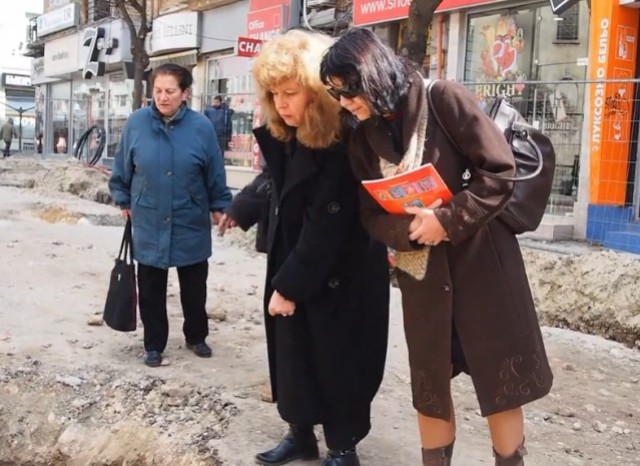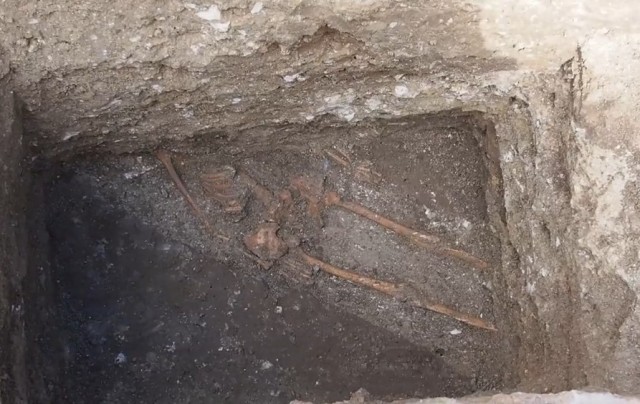‘Giant’ Skeleton Found under Odessos Fortress Wall in Bulgaria’s Varna Not Fully Dug Up, Measured Yet, Archaeologists Inform

A closeup of the “giant” man’s skeleton which is still partly buried under the Late Antiquity fortress wall of ancient Odessos in the downtown of the Bulgarian Black Sea city of Varna. Photo: TV grab from Nova TV
The skeleton of a tall man that has been discovered under the fortress wall of the ancient city of Odessos in Bulgaria’s Varna during rescue excavations earlier in March 2015 has not been completely unearthed and measured yet.
This has been made clear by Prof. Dr. Valeri Yotov from the Varna Museum of Archaeology (Varna Regional Museum of History), who is in charge of the rescue digs in the downtown of the Black Sea city, as cited by the Bulgarian daily Standart.
The story about the discovery of the seemingly giant skeleton partly buried under the fortress wall of the Ancient Thracian, Greek, and Roman city of Odessos (Odessus) on March 17, 2015, has become the most read story published by “Archaeology in Bulgaria” so far, and has been cited by archaeology and general interest sites from around the world. However, readers have been left to wonder about the precise size of the Varna skeleton.
Ten days later this question remains unanswered as it turns out that the Bulgarian archaeologists, following a very gradual approach, have not dug up the skeleton completely yet, and, respectively, have not measured and studied the bones.
Lead archaeologist Prof. Dr. Valeri Yotov has been trying to convince the media and the passers-by in downtown Varna that the discovery of the “giant” skeleton is not the most interesting development about the rescue excavations of ancient Odessos “despite the recent interest in vampires and ancient dead men”, the Standart daily reports.
“That is not the case here,” Yotov is quoted as saying, reiterating his earlier comments that there was nothing unusual about the skeleton find, and that the man buried below the Odessos fortress wall was neither or a “vampire”, nor a representative of some race of ancient giants.
He sticks to his working hypothesis that the man in question, whose skeleton is dated back to the late 4th century or early 5th century, was probably a construction worker who died during the construction of the Odessos (Odessus) fortress wall, possibly from a work-related incident, and was buried right on the spot, in a pit dug up for construction purposes.

For 10 days now curious passers-by have been able to check out the “giant” ancient man’s skeleton found below the fortress wall of ancient Odessos in Bulgaria’s Varna, as the archaeologists still haven’t removed it from the site. Photo: TV grab from Nova TV
Instead of focusing on the tall man’s skeleton, the archaeologists from Bulgaria’s Varna are now focused on discovering the main gate of ancient Odessos.
During the rescue excavations so far the researchers from the Varna Museum of Archaeology have discovered ancient earthen jars as well as a hand mill and a new section of the fortress wall of Odessos.
The digs were undertaken in the area around the St. Nikolay Church and the so called Varna Largo along the Knyaz Boris I Boulevard, the pedestrian zone in the Black Sea city, after in January 2015, construction workers found an earthen jar, or pithos, during rehabilitation and reconstruction works. Also in January 2015, construction workers rediscovered a long-forgotten Ancient Roman tomb nearby.
Despite the numerous new discoveries, the local archaeologists still have no information about the main gate, or the entrance of ancient Odessos, another archaeologist from the Varna Museum, Alexander Minchev, is quoted as saying.
According to lead archaeologist Yotov, it is possible that the current excavations might stumble upon one of the gate of the Late Antiquity fortress of Odessos (Odessus), and the road which led to another Ancient Thracian, Greek, and Roman city on the Bulgarian Black Sea coast, Dionysopolis, today’s resort town of Balchik.
Yotov has explained further that rescue excavations in downtown Varna back in the 1970s revealed that the area was the location of a fortress tower connected with the system of ancient fortifications of Odessos, and that the recent accidental discovery of the northeastern fortress wall during the rehabilitation and construction works was not entirely unexpected.
The exact location of the fortress tower in question is near a fountain with dolphin statues in front of the St. Nikolay Church. This is an area yet to be excavated during the ongoing digs. The foundations of the fortress tower are at a depth of 2 meters, and are 3.7 meters wide.

The unearthed 4th-5th century AD skeleton of the tall man buried under the Odessos fortress wall has been lying “in situ” since it was found on March 17, 2015. Photo: TV grab from Nova TV
“Ancient Odessos had several fortress walls from different periods – a wall from the Hellenistic Period BC, a Roman fortress wall with one tower which is under today’s pedestrian zone, and now the newly found Late Antiquity wall,” the lead archaeologist explains.
The first two fortress walls are located in the so called “Varna Hole”, a large pit in the downtown originally dug up for the construction of a Communist Era department store in 1980s which has been used as a paid parking lot after the abandonment of the project, and is seen as a symbol of government mismanagement.
Yotov reminds that the Varna Hole was supposed to be transformed into an open air museum because of the Odessos wall remains it features but it is known when and how these plans might be realized. He emphasizes the importance of excavating the newly found Late Antiquity fortress wall because it might lead the archaeologists to more buildings inside the wall.
The Varna archaeologists intend to make a formal suggestion to the Bulgarian Ministry of Culture and Varna Municipality that the newly uncovered remains of ancient Odessos be restored and exhibited in situ as part of the new look of the Varna Largo, a busy pedestrian area visited by many tourists, including from abroad. Even the earthen jar whose discovery triggered the current rescue excavations may be preserved and exhibited in the original location where it was found.
According to the head of the Varna Museum of Archaeology, Prof. Dr. Valentin Pletnyov, a 20-meter section of the Odessos fortress wall is likely to be built into the new pedestrian zone at the Varna Largo.
He also confirms that the archaeologists had had a general idea about the location of the newly found Late Antiquity wall of Odessos but had not stumbled upon it before the present excavations.
Varna Mayor Ivan Portnih is also reported to be in favor of the in situ exhibition of the new Odessos finds. Varna Municipality, which is the investor in the project for the rehabilitation of the downtown, will also foot the bill for the current rescue excavations whose cost is estimated at BGN 10,000 (app. EUR 5,100).
Background Infonotes:
The dawn of Varna‘s history dates back to the dawn of human civilization, the Eneolithic Varna Necropolis being especially well known with the discovery of the world’s oldest find of gold artifacts dating back to the 5th millenium BC.
Ancient Odessos is considered the precursor of the Bulgarian Black Sea city of Varna. It was founded by Miletian Greek colonists at the end of 7th century BC, the earliest Greek archaeological material dating back to 600-575 BC. However, the Greek colony was established within an earlier Ancient Thracian settlement, and the name Odessos had existed before the arrival of the Miletian Greeks and might have been of Carian origin. Odessos as the Roman city of Odessus became part of the Roman Empire in 15 AD when it was incorporated in the Roman province Moesia. Roman Odessos is especially known today for its well preserved public baths, or thermae, the largest Roman single structure remains in Bulgaria, and the fourth largest Roman public baths known in Europe.
The First Bulgarian Empire (680-1018 AD) conquered Odessos (Varna) from Rome‘s successor, the Eastern Roman Empire, or Byzantium, in the late 7th century. It is even believed that the peace treaty in which the Byzantine Empire recognized the ceding of its northern territories along the Danube to Bulgaria was signed in Odessos. The v(val) that the first ruler of Danube Bulgaria, Khan (or kanas) Asparuh built at the time as a defense against future Byzantine incursions is still standing. Numerous Ancient Bulgar settlements around Varna have been excavated, and the First Bulgarian Empire had its first two capitals Pliska (681-893 AD) and Veliki (Great) Preslav (893-970 AD) just 70-80 km to the west of Varna. It is suggested that the name of Varna itself is of Bulgar origin. In the Middle Ages, as a coastal city, Varna changed hands between Bulgaria and Byzantium several times. It was reconquered for the Second Bulgarian Empire (1185-1396 AD) by Tsar Kaloyan (r. 1197-1207 AD) in 1201 AD.
The Varna Hole is a pit dug up for the construction of a department store in 1984 but abandoned after the collapse of Bulgaria’s communist regime in 1989. It is presently used as a paid parking lot. It is intriguing because it features remains of the Ancient Roman fortress wall of Odessos / Odessus dating back to the 1st century AD as well as preserved walls of the Ancient Greek colony of Odessos dating back to the 5th century BC.










